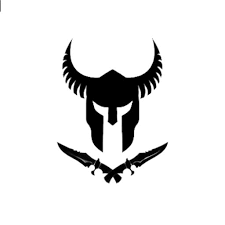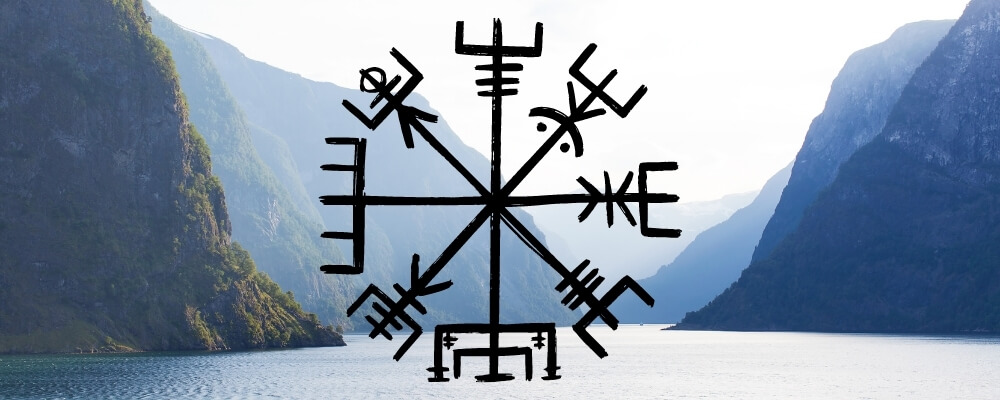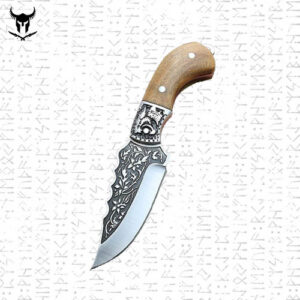The Vikings have left behind a fascinating cultural legacy, including mystical symbols and runes that continue to intrigue and captivate our imagination. One of these symbols is the Viking compass, also known as Vegvísir. In this article, we will explore in detail the meaning and history of this mystical compass and how it can guide you in your life.
Summary
ToggleWhat is the Viking Compass or Vegvísir?
The Viking compass, or Vegvísir in Old Norse, is a navigation symbol used by ancient Vikings. It is represented as a circle with eight rays, often surrounded by runes. Vegvísir literally means “wayfinder” in Old Norse, and it is said to have the power to guide sailors and travelers through storms and challenging weather conditions.
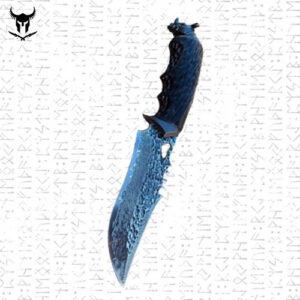
High Hardness Outdoor Hunting Knife for Risk Prevention
⚒️ A blade, a legacy — forge yours now.
Buy nowOrigin and Meaning of the Viking Compass Vegvísir:
The exact origin of the Viking compass Vegvísir remains a mystery, but it is first mentioned in an ancient Icelandic manuscript called the “Grimoire of Galdrabók.” The symbol was later popularized in the 18th-century “Huld Manuscript.” While its precise use in Viking practices is still debated, Vegvísir is often associated with magic, protection, and navigation.
The Vegvísir is designed to assist those who use it in finding their way, whether on the sea or on land. It is considered a symbol of good fortune, safety, and guidance. According to legend, Vegvísir can prevent its bearer from getting lost and enable them to safely return home, regardless of the circumstances.
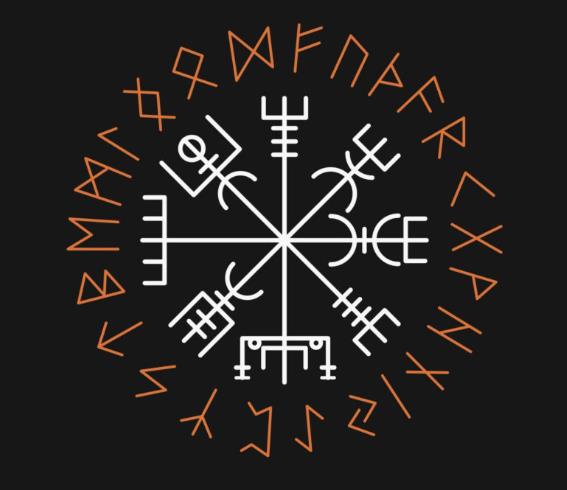
How Does the Viking Compass Work?
The Viking compass Vegvísir operates symbolically rather than practically. Unlike modern compasses that use a magnetic needle to indicate direction, Vegvísir acts as a spiritual and symbolic guide. The central circle of Vegvísir represents the starting point, the center of your being. The eight rays extending from the circle represent the possible paths ahead of you. Each ray can symbolize a direction, a decision, or a choice to make. By meditating or focusing on Vegvísir, some believe they can connect with their intuition, inner wisdom, and the forces of the universe. The symbol is supposed to guide them in the right direction, help them make decisions, and find their way in life, much like the Vikings used it to navigate through turbulent seas.
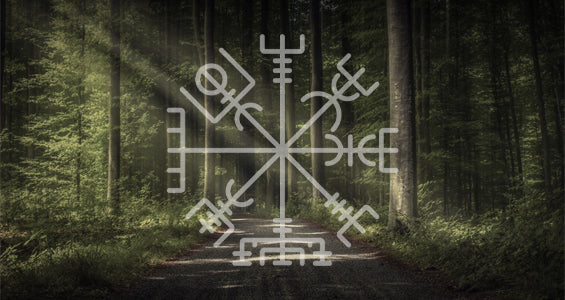
It is important to emphasize that Vegvísir is not a physical compass and does not provide precise landmarks for terrestrial or maritime navigation. Its operation is more based on self-confidence and spiritual guidance. When using Vegvísir as a symbolic tool, it is essential to connect with your intuition and listen to the inner answers that emerge. It serves as a reminder to trust your own internal compass and follow your unique path. In summary, the Viking compass Vegvísir functions as a symbolic guide, helping individuals find their direction in life by connecting with their intuition and inner wisdom.
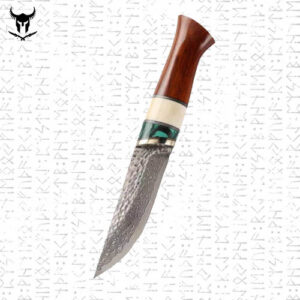
Norwegian Survival Knife In Damascus Steel Sharp And Durable With An Animal Bone Handle
⚒️ A blade, a legacy — forge yours now.
Buy nowThe 8 Branches of Vegvisir: The Norse Compass
Vegvisir is an ancient Icelandic symbol, also known as the “runic compass.” It consists of eight branches, forming a sort of compass or wind rose. The eight branches of Vegvisir are represented by runes and carry profound meanings. Each of the branches is associated with a cardinal point as well as specific concepts and powers.
Here is an overview of the eight branches of Vegvisir:
- North (Nórdur): Representing cold and ice, this branch symbolizes stability and protection against natural elements.
- Northeast (Norðaustur): Associated with dawn and rebirth, this branch evokes new directions, hope, and opportunities.
- East (Austur): Symbolizing knowledge and intellect, this branch encourages learning and exploring new ideas.
- Southeast (Suðaustur): Representing the rising sun and vitality, this branch symbolizes healing, growth, and renewed energy.
- South (Suður): Associated with warmth and fire, this branch represents passion, creativity, and protection against dangers.
- Southwest (Suðvestur): Symbolizing transition and change, this branch evokes personal transformation and adaptability.
- West (Vestur): Representing water and emotions, this branch symbolizes intuition, balance, and inner wisdom.
- Northwest (Norönn-viðri): Associated with twilight and darkness, this branch symbolizes protection against negative influences and maintaining inner strength.
Together, these eight branches of Vegvisir offer comprehensive guidance and protection, both in the physical and spiritual realms. The Vegvisir symbol is often used as a talisman to guide and protect those who wear it during their journeys and explorations, inspired by the wisdom of the Vikings.
Contemporary Use of Vegvísir:
In modern times, the Viking compass Vegvísir has become a popular symbol in Nordic culture and among Viking enthusiasts. It is commonly found in the form of tattoos, jewelry, decorative motifs, and even fashion items. People wear Vegvísir as a reminder of their Viking heritage, as well as a symbol of protection and guidance in their daily lives.
Due to its growing popularity, Vegvísir is also used by some neo-pagan and Wiccan groups, who attribute magical and spiritual powers to it. However, it is important to note that modern interpretations and uses of Vegvísir can vary significantly, and each person is free to give this symbol the meaning they choose.
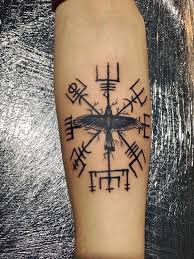
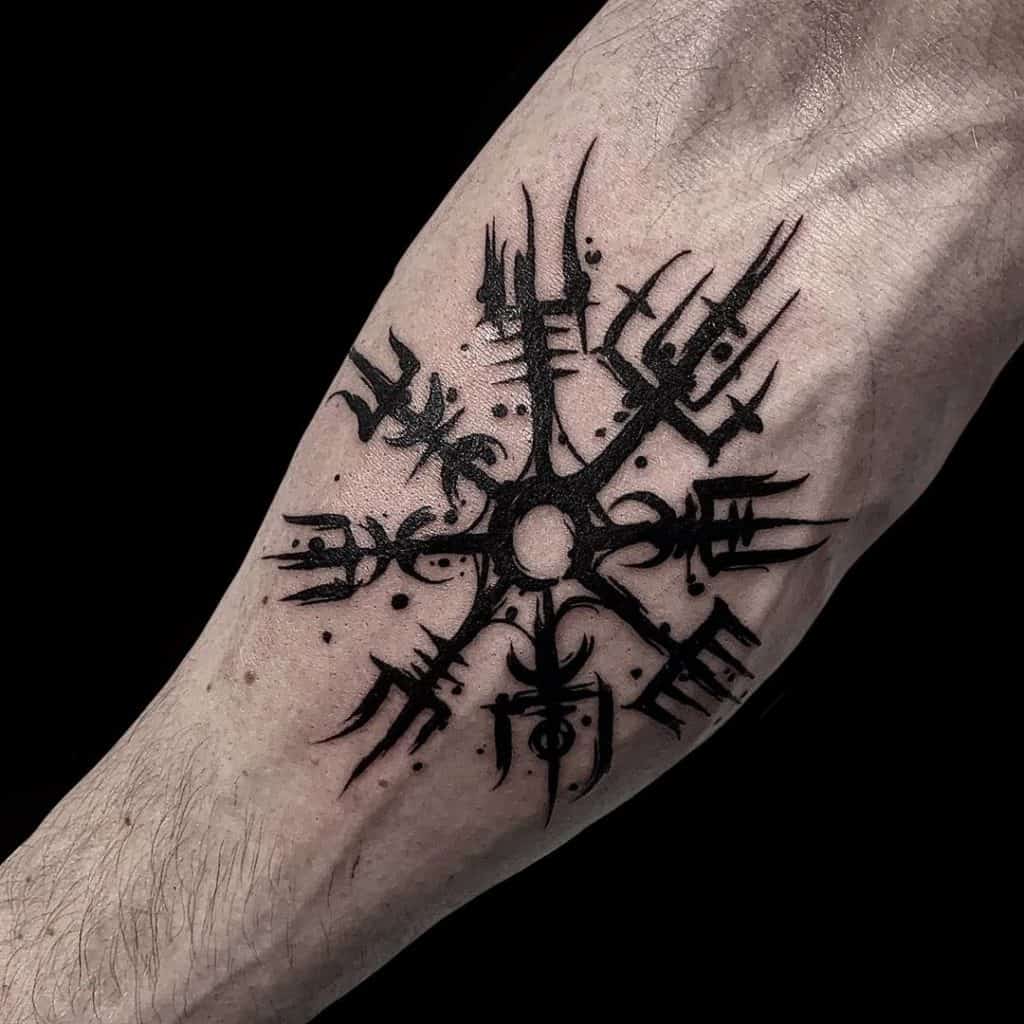
Meaning of the Viking Compass Tattoo:
A Viking compass tattoo can hold deep significance for those who choose to wear it. The compass is an important symbol in Viking culture, representing not only navigation but also the direction one wishes to take in life. The Vikings were fearless explorers who sailed the seas to discover new lands and expand their influence. A Viking compass tattoo can, therefore, serve as a reminder of that bold and adventurous era, as well as a symbol of the direction one wishes to take in their own life. Viking compass tattoo designs can vary in size and detail, but they often incorporate elements of traditional Viking art, such as Celtic knot patterns and runes.

Viking Hunting Knife with Handcrafted Damascus Steel Forged Core
⚒️ A blade, a legacy — forge yours now.
Buy nowFAQ: Frequently Asked Questions About Vegvísir:
The eight rays of Vegvísir are often interpreted as paths or directions to follow. They represent guidance and protection in all directions, indicating that Vegvísir can help you find your way, no matter where you are.
Yes, modern versions of Vegvísir can vary in terms of design and details compared to historical representations. However, the general idea and meaning of the symbol remain the same.
No, Vegvísir is not specifically associated with a religion. While it has ties to ancient Norse beliefs, it is often used as a cultural and spiritual symbol rather than a religious one.
The Viking compass Vegvísir is primarily considered a symbolic and artistic representation rather than a practical navigation instrument. If you need a functional compass, it is best to use modern devices designed for that purpose.
You can incorporate Vegvísir into your daily life in various ways, such as wearing it as jewelry, using it as a decorative motif, or even getting it as a tattoo. Choose the method that suits you best and aligns with the meaning you wish to attribute to this symbol.
Over the centuries, the Viking compass Vegvísir has retained its mystical aura and profound meaning. Whether you are drawn to Viking history, magic, or simply seeking a symbol of guidance, Vegvísir offers a fascinating exploration of Nordic heritage. Regardless of your interpretation of Vegvísir, whether it’s a cultural, spiritual, or purely aesthetic symbol, let this ancient compass guide you on your own path.
